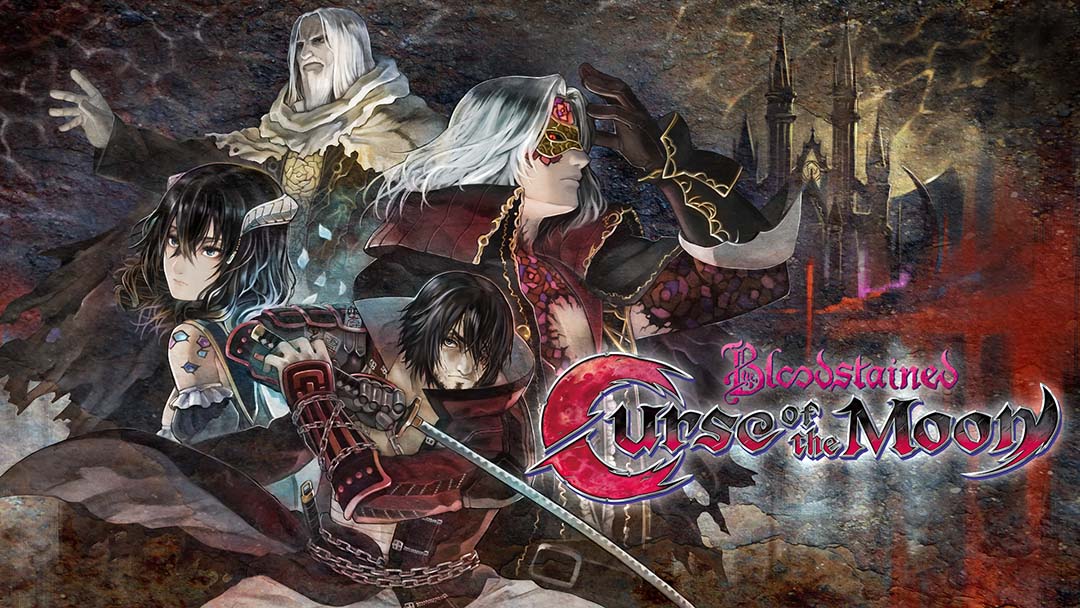
The night is dark and full of terrors. Back in the NES days, we had Castlevania to help us fight back the terrors of the dark, adventure games full of hidden paths, treasures and secrets to hunt down and find, incredible bosses to test our endurance and our sanity against. There have been games here and there attempting to reclaim the feel of the early games. Since they are not the old games, they don’t give rise to that nostalgic feeling that helped define a generation. Bloodstained: Curse of the Moon, the spiritual successor to the original Castlevania series and a prequel to Bloodstained: Ritual of the Night, excellently revives that nostalgia that has been missing for so long.
Bloodstained: Curse of the Moon
Publisher: Inti Creates Co., Ltd.
Developer: Inti Creates Co., Ltd.
Platform: PC, PlayStation 4, PlayStation Vita, Xbox One, Nintendo Switch (Reviewed), 3DS
Release Date: May 24th, 2018
Players: 1 Player
Price: $9.99

Bloodstained: Curse of the Moon is an action-adventure game in the same vein as the early Castlevania games. The game is a prologue to the kickstarted game, Bloodstained: Ritual of the Night, which is slated to release later this year.
Curse of the Moon explains the start of the game and introduces the later games major characters, Miriam and Gebel, along with 2 other characters, Zangetsu and Alfred. Bloodstained plays very similarly to the old school Castlevania games, where the player is tasked with with exploring a specific stage of the game and confronts a boss at the end.
Coupled with various platforming elements and few secrets to find in each stage, older gamers will immediately feel at home in the atmosphere presented here. Newer gamers or ones not accustomed to the older games might feel put off with the gameplay elements presented, as they are very true to the old 8-bit adventure games that Bloodstained is a homage to.
The game features 4 distinct playable characters, each with their own strengths and weaknesses and their own sub weapons (mostly) to be found within each stage. Zangetsu has short range, but strong attacks. Miriam has range and higher jumps than any other character. Alfred has the lowest life of any of the playable characters, but immensely strong subweapons at his disposal. And Gebel has no subweapons that he can use, but has a very strong ability that allows him turn into a bat and basically one hit kill most normal enemies, at the cost of transforming back if he is hit.

This mix of characters allows the player to choose different paths throughout the game, allowing a bit of exploration in each stage. Certain paths will be more difficult, while others will lead to items that increase all characters health or the number of times each character can use their subweapon.
However, no matter which path a player chooses, each stage will culminate with a boss that the player will need to vanquish to continue on. On the players first play through the game, the first 3 stages will end with a choice of whether or not to recruit the remaining playable characters, as you start out only being able to control Zangetsu.
The platforming segments at times require specific timing and spacing to successfully pull off, else wise the player will be returning to the start of the stage in order to attempt that segment over again (unless you want to face the bosses down a character that might prove useful).
The game does offer a casual mode that negates push back when hit by an enemy and also provides an infinite number of lives. This may sound a bit unfair, but I played through the game on both normal and casual modes. Really, I never once lost a “life”, as you need to lose all four characters in a given stage before you’re prompted with a continue screen.
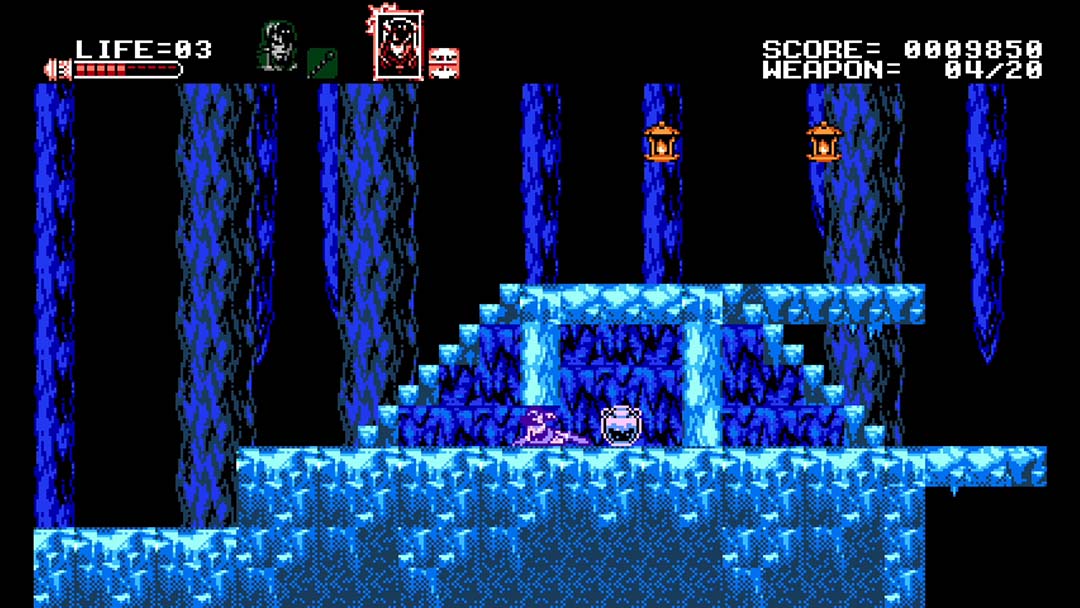
Besides, at any time during a stage, the player can choose to activate the “Curse of the Moon”, which allows you to go back and re-do any stage you’ve unlocked up till that point, at the cost of losing any of the special increase items found in that stage.
I admit to making liberal use of throughout my playthrough. There are certain paths that only certain characters can open and some of the paths are much easier when certain characters are available.
These aspects, the timing involved with parts of the platforming, how an ill equipped sub weapon can hamper you in segments of the stage or against the boss, a re-emergence of some very annoying 8-bit level design hazards, can lead to headaches and lost tempers.
The game gives ample ways to side step these aspects, leading Bloodstained to be almost on the easy side. Missed a jump with a valuable character? Restart the stage with full life and all characters returned at the cost of all subweapon energy.
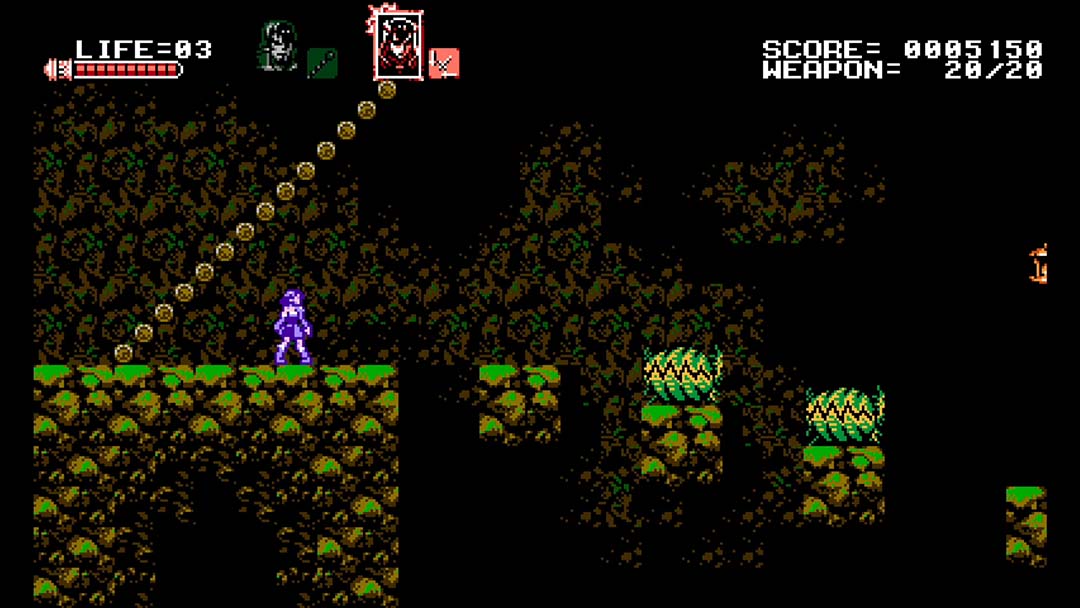
Did you choose a bad path? Restart the stage. Even if you lose 3 of the 4 playable characters, when you move on to the next stage, all 4 characters will be available at the start of the next stage.
Beyond that, the game is short. There are 4 normal stages, followed by a final stage broken into 4 other stages. One playthrough will take a player around 5 hours or so if they’re familiar with this type of game. Perhaps a bit more if a player is new to older based games.
A single playthrough should not take an exorbitant amount of time. The short length of each playthrough actually plays to one of the games strengths: Multiple endings. Bloodstained: Curse of the Moon has a total of 9 different endings for the player to experience.
However, there are really only 3 that need to be seen if the player wants to be fully informed with the lore before the second game is released. The “good” ending, seen at the end of the normal path, the “true” ending, seen at the end of the nightmare path and the “bad” ending, if the player chooses not to recruit any of the 3 other playable characters and completes a full run on the normal path.
Speaking of lore, Bloodstained is a prequel to the original game that was funded on Kickstarter, and is very much an 8-bit game that was designed as a kickstarted goal. As such, the story in the game is a bit on the light side.
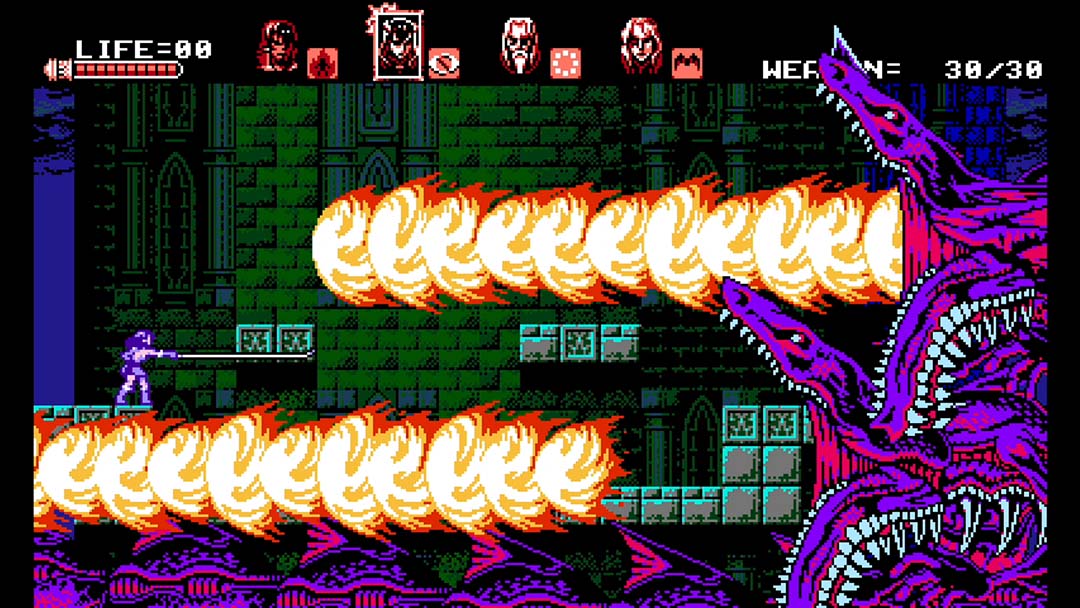
The full story will be released once Bloodstained: Ritual of the Night is released, but Curse of the Moon does offer a bit of back story and is well worth the playthroughs if a player is interested in getting the full experience once the main game is launched.
Bloodstained: Curse of the Moon follows a demon hunter by the name of Zangetsu, who has been cursed by the very demons he has sworn to hunt. Miriam and Gebel, as mentioned earlier, will play a major role in Ritual of the Night once it launches and Curse of the Moon gives a player a bit more insight in to their background.
Not much is said, but it supposedly does give some of the reasons why events happen in the next game and helps set it up. But as this is about Curse of the Moon and not Ritual of the Night, the lack of story is a bit of a detriment. There is enough to carry an 8-bit game, but there could have been a bit more.
Visually, Bloodstained: Curse of the Moon is every bit the games it pays homage to. Based around an 8-bit aesthetic, Curse of the Moon fully shows off how well an 8-bit game can be done on modern architecture without feeling cliched or forced. The level of detail found in the environments and on the larger monsters and bosses is fantastic.
The smaller monsters and characters do lose a bit in terms of the detail department, but the lost detail is not a major impact. None of the character or monster models ever appear muddy or indistinguishable. I played Curse of the Moon on the Switch, mostly in handheld mode and never had an issue telling different aspects of the scene apart.
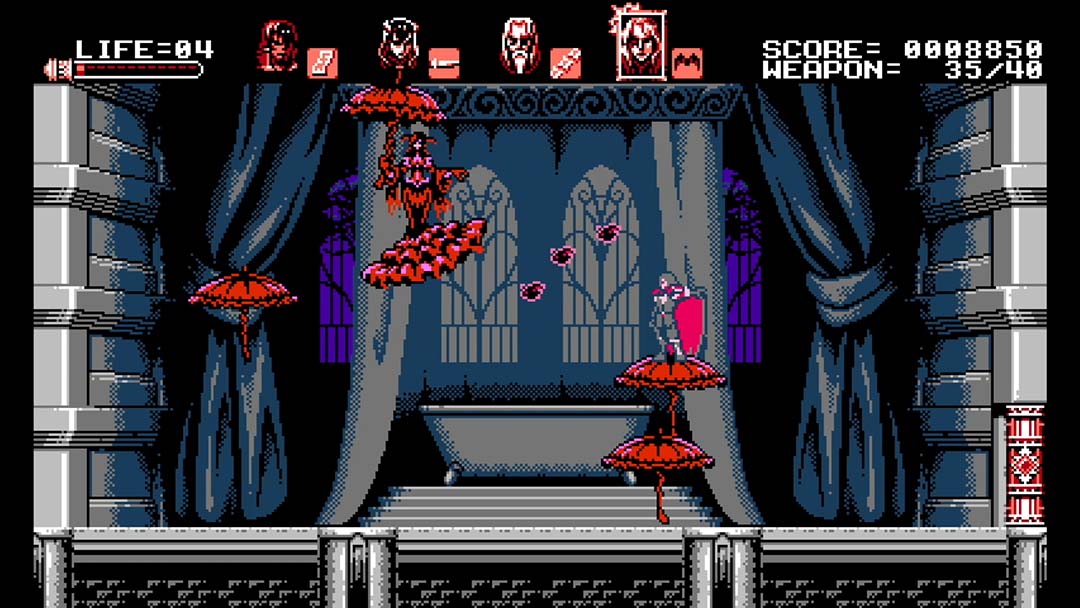
In the same vein, the music is every bit as retro as the visual style. Not only was the game produced by the same man who produced the original Castlevania games, Curse of the Moon features music composed by the woman who composed almost all of the music for that series as well.
Not only did Michiru Yamane come in on the project, but Ippo Yamada also helped co-compose for the game. The music is absolutely fantastic and just oozes the gothic horror that the older games were so well known for.
Each track of the game perfectly fits the scene and adds just the right touch of suspense during the boss fights. The final fights in both the good and true endings are emotional and add just the right amount of atmosphere to the fights.
Bloodstained: Curse of the Moon is very much a game for fans but is also very approachable for new comers to the genre of game. The difficulty is a bit on the low end, rarely ever truly testing the player except for a few spots in the late game.
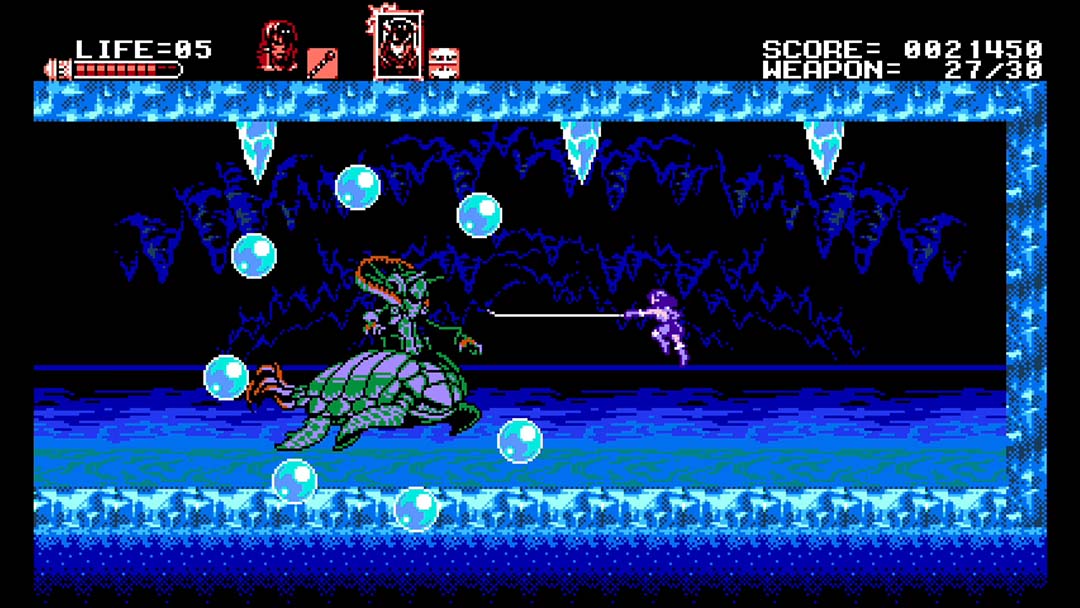
While the story is more than a bit light, Curse of the Moon pays homage to older games and it is a prequel to a game that is yet to be released. There are a few slight faults here and there throughout the game, but on average, Curse of the Moon is a gem of a game that harkens back to an older era of gaming all but lost in the last few generations.
Curse of the Moon might be on the short side, but the price point of the game makes it a very cost effective use of 10-15 hours. The night might be dark and full of terrors, but Curse of the Moon gives us some very effective tools to take down the evils that lurk within.
Bloodstained: Curse of the Moon was reviewed on Switch using a review copy provided by Inti Creates. You can find additional information about Niche Gamer’s review/ethics policy here.
The Verdict: 9
The Good
- Fantastic use of the 8-bit aesthetic
- An amazing sound track that fits the game and leaves the player wanting more
- Diverse characters that each add to the game and allows for interesting exploration
- A homage to older games that does the older games without feeling cheap, cliché or borrowed
The Bad
- Very short
- Difficulty is fairly low. Most experienced players won’t be challenged and even new players won’t have much issue completing the game